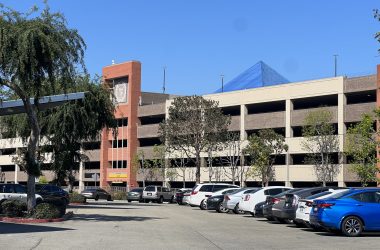Cal State Long Beach students, faculty and staff are being asked to stop what they are doing at 10:15 a.m. tomorrow and volunteer to drop, cover and hold on.
California will be hosting the second annual Great California ShakeOut to re-enact the experience of a major earthquake. This year, about 6.5 million people and 481 schools or districts have pledged to volunteer on the Shake Out Web site.
“We need to be ready; we are in earthquake country,” said Sgt. Rick Goodwin, Emergency Operations Center coordinator of University Police.
The San Andreas fault is the focus of the ShakeOut, as it is estimated to cause an earthquake within 30 years. This fault line is miles away from campus even though residents in Long Beach would feel the effect. The Newport-Inglewood fault line would be the cause of greater damage in Long Beach.
In 1933, the Newport-Inglewood fault shook, causing a 6.3 magnitude earthquake that was centered in Newport. It caused fatalities and major damage to buildings.
“If we had a similar earthquake as we did in 1933, we would have more damage to buildings and homes,” said Nate Onderdonk, a CSULB geology professor. There has been a lot more construction of building and homes than in 1933.
The Newport-Inglewood fault has not been studied in detail like the San Andreas fault. There is very little information about how much the fault is slipping, Onderdonk said.
CSULB sits on top of a hill gradually being made by the movement of the Newport-Inglewood fault.
“The fault itself sits southwest of PCH; you can see it out on Bolsa Chica,” Onderdonk said. On the surface, the fault splits into many small cracks.
The building code is constantly changing and, therefore, many buildings are not up to date.
“The new science building has diagonal braces to help them move side to side in case an earthquake happens,” Onderdonk said.
Buildings such as apartment complexes with underground parking garages are prone to collapse during an earthquake, as was the case during the 1994 Northridge quake, Onderdonk said.
Even though the campus will not require any formal exercise for the drill, Goodwin said the emergency operations center will practice a “table top” exercise.
People will come in and act as if an earthquake just happened, and they will run through the steps needed in order to handle the situation, allowing them to use the day to help coordinate for a possible future emergency response.
The purpose of the earthquake drill is to keep people prepared for an emergency. People need to know their surroundings and try to avoid sitting by the windows in classrooms, for example.
“My goal is to see that the people just think about being prepared,” Goodwin said, adding that people need to make sure they take cover. “More people are hurt by falling debris.”
Web sites such as ready.gov offer tips and information to help people survive an emergency.




